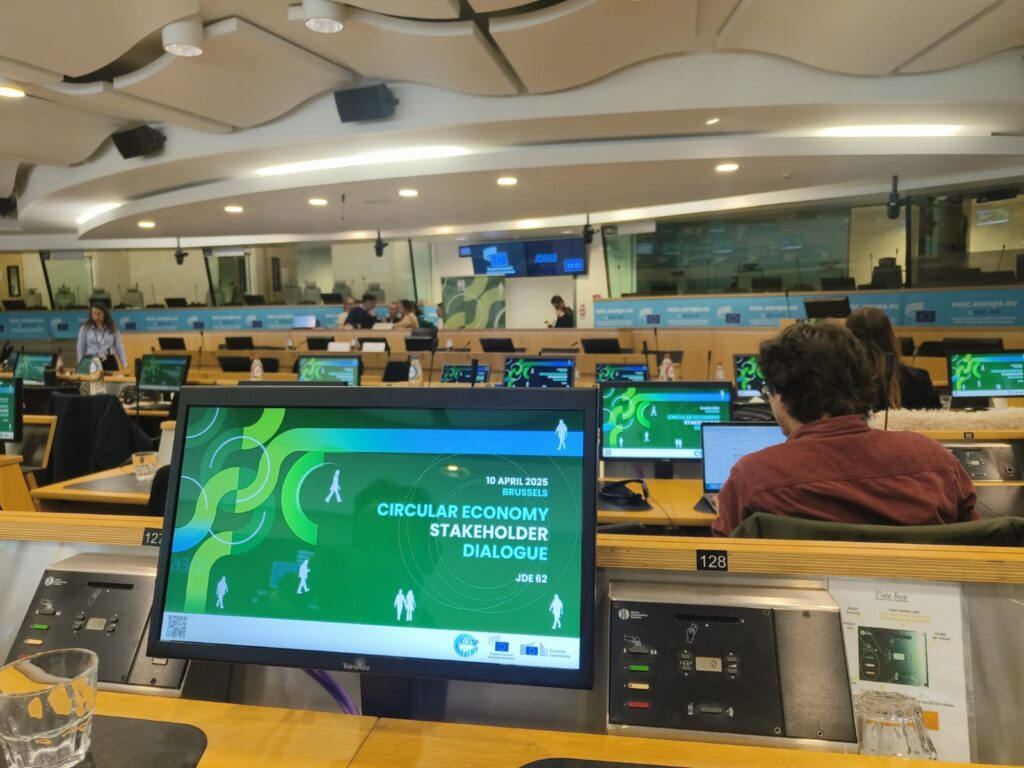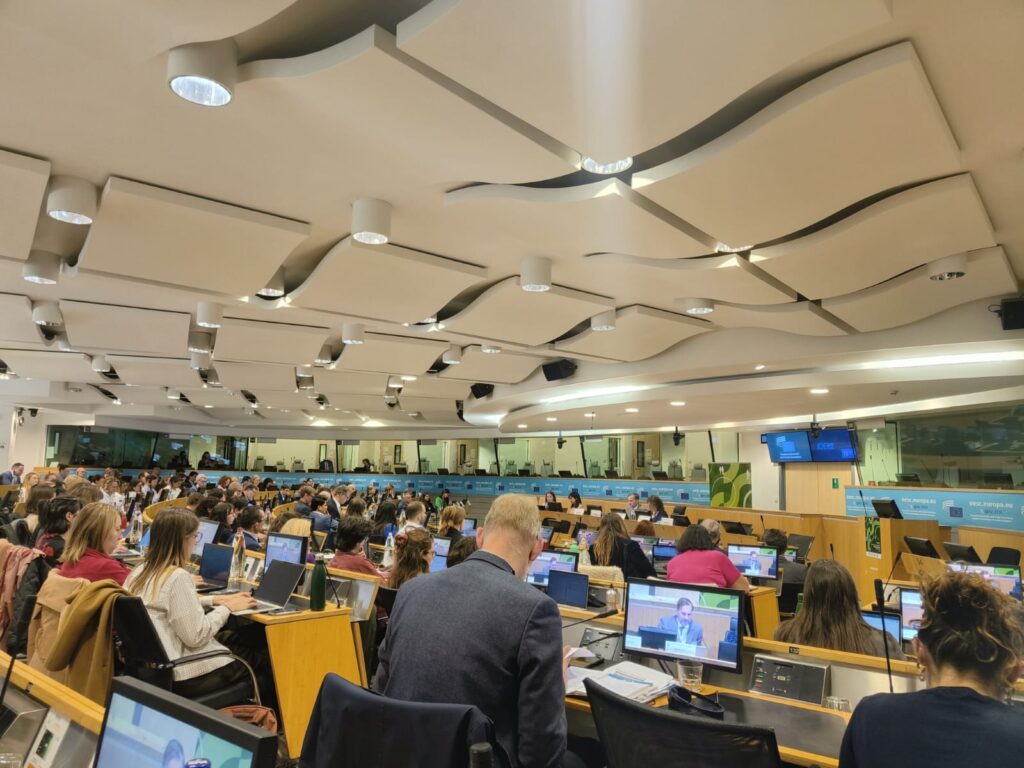
Inclusivity is at the heart of a circular economy. For a circular transition that is just and equitable, no one should be left behind—an urgent imperative echoed in the EU Green Deal. Right from the start, stakeholders’ views must be accounted for by policymakers to design a system that is cognisant of the environment, economy, and society’s wellbeing, while being mindful of the limits to growth.
This intention was made amply clear at the high-level Circular Economy Stakeholder Dialogue organised by the European Circular Economy Stakeholder Platform (ECESP) in Brussels on April 10. International Solid Waste Association (ISWA), the communications and dissemination partner in the W2W project, represented the EU-funded project consortium at the event.
The purpose of the dialogue was to provide a forum for stakeholders to share views and offer feedback on ongoing legislative proposals and gather insights that will contribute to EU Green Week in June.
As an EU-funded project, participation in the dialogue was crucial for Wood2Wood as we are developing a wood waste classification framework that will help to improve material flow management and support the transition towards a more circular wood supply chain in the European Union. This carries the potential to reduce Europe’s strategic dependency on global supply chains and build greater autonomy and resilience, which is critical for maintaining the competitiveness of European industry.
However, this requires consistency in legislations.

Thus, the dialogue was the right platform to raise this question to policymakers and other stakeholders.
The event kick-started with some high-level remarks from European Commission officials followed by a discussion on the Clean Industrial Deal, and four thematic breakout sessions focusing on the EU Bioeconomy Strategy and the Circular Economy Act.
Luis Planas Herrera, DG Environment, emphasised the bioeconomy strategy which is key to European resilience and competitiveness.
“𝐁𝐢𝐨𝐞𝐜𝐨𝐧𝐨𝐦𝐲 𝐢𝐬 𝐢𝐦𝐩𝐨𝐫𝐭𝐚𝐧𝐭 𝐟𝐨𝐫 𝐄𝐮𝐫𝐨𝐩𝐞’𝐬 𝐜𝐨𝐦𝐩𝐞𝐭𝐢𝐭𝐢𝐯𝐞𝐧𝐞𝐬𝐬 𝐚𝐧𝐝 𝐫𝐞𝐬𝐢𝐥𝐢𝐞𝐧𝐜𝐞, 𝐚𝐧𝐝 𝐭𝐨 𝐜𝐨𝐧𝐭𝐢𝐧𝐮𝐞 𝐝𝐞𝐜𝐨𝐮𝐩𝐥𝐢𝐧𝐠 𝐟𝐫𝐨𝐦 𝐟𝐨𝐬𝐬𝐢𝐥 𝐟𝐮𝐞𝐥 𝐦𝐚𝐭𝐞𝐫𝐢𝐚𝐥𝐬. 𝐈𝐭 𝐢𝐬 𝐢𝐦𝐩𝐨𝐫𝐭𝐚𝐧𝐭 𝐭𝐡𝐚𝐭 𝐄𝐔 𝐛𝐞𝐜𝐨𝐦𝐞𝐬 𝐚 𝐥𝐞𝐚𝐝𝐞𝐫 𝐨𝐧 𝐭𝐡𝐢𝐬 𝐟𝐫𝐨𝐧𝐭, 𝐚𝐧𝐝 𝐰𝐞 𝐰𝐚𝐧𝐭 𝐭𝐨 𝐞𝐧𝐬𝐮𝐫𝐞 𝐡𝐨𝐰 𝐭𝐨 𝐦𝐚𝐤𝐞 𝐦𝐨𝐫𝐞 𝐮𝐬𝐞 𝐨𝐟 𝐢𝐧𝐝𝐮𝐬𝐭𝐫𝐢𝐚𝐥 𝐚𝐩𝐩𝐥𝐢𝐜𝐚𝐭𝐢𝐨𝐧𝐬 𝐚𝐧𝐝 𝐦𝐚𝐫𝐤𝐞𝐭𝐬 𝐟𝐨𝐫 𝐛𝐢𝐨-𝐛𝐚𝐬𝐞𝐝 𝐦𝐚𝐭𝐞𝐫𝐢𝐚𝐥𝐬, 𝐰𝐡𝐢𝐜𝐡 𝐚𝐫𝐞 𝐤𝐞𝐲 𝐢𝐧 𝐭𝐡𝐞 𝐂𝐢𝐫𝐜𝐮𝐥𝐚𝐫 𝐄𝐜𝐨𝐧𝐨𝐦𝐲 𝐜𝐨𝐧𝐭𝐞𝐱𝐭,” said Herrera.
This speaks directly to our project, as our core objective is to use a wood waste cascade upcycling valorisation approach. By efficiently utilising resources using residues and recycled materials for material use, we will 𝒆𝒙𝒕𝒆𝒏𝒅 𝒕𝒐𝒕𝒂𝒍 𝒃𝒊𝒐𝒎𝒂𝒔𝒔 𝒂𝒗𝒂𝒊𝒍𝒂𝒃𝒊𝒍𝒊𝒕𝒚 𝒘𝒊𝒕𝒉𝒊𝒏 𝒂 𝒈𝒊𝒗𝒆𝒏 𝒔𝒚𝒔𝒕𝒆𝒎—in our case, the EU’s wood-based industries.
Wood2Wood project aims to increase use of secondary raw materials like wood waste derived from construction and demolition (C&D) and furniture sectors to make high-value products and reduce waste that ends up in landfills or incineration facilities.
We will demonstrate the efficient and sustainable value chains for the production of:
- Wood without pollutants
- Biocomposite building materials
- Biopolymers
- Polyols
- Chemical detergents
- Recovery of nutrients, through the use of technologies and tools that allow the selection of optimal cascade paths for further uses of wood products and their materials.
This is how W2W will support the transition towards a circular economy by promoting closed-loop systems where materials are continually repurposed and reused, extending their useful life.
As mentioned earlier, W2W asked this question on Green Skills and that speaks to our recently held REACT Cluster Webinar series: “How can industries attract and retain top talent in today’s rapidly evolving landscape?”
Our engagement at ECESP is important because:
- We recognise that automation and digitalisation is reshaping the industrial sector
- Upskilling and talent retention are key to ensuring a future-proof workforce.
But how to start this process?
Earlier last month, Jorge Tiago Martins from VTT designed a Horizon Scanning Survey asking for feedback from Circular Economy stakeholders with the same question: What are the emerging future green skills required to drive these circular strategies and processes for a circular transition?
The Breakout Session 2 on “𝐄𝐦𝐛𝐞𝐝𝐝𝐢𝐧𝐠 𝐭𝐡𝐞 𝐜𝐢𝐫𝐜𝐮𝐥𝐚𝐫 𝐛𝐢𝐨𝐞𝐜𝐨𝐧𝐨𝐦𝐲 𝐢𝐧 𝐭𝐡𝐞 𝐄𝐮𝐫𝐨𝐩𝐞𝐚𝐧 𝐯𝐚𝐥𝐮𝐞 𝐜𝐡𝐚𝐢𝐧 𝐭𝐨 𝐬𝐞𝐜𝐮𝐫𝐞 𝐭𝐡𝐞 𝐄𝐔’𝐬 𝐬𝐭𝐫𝐚𝐭𝐞𝐠𝐢𝐜 𝐚𝐮𝐭𝐨𝐧𝐨𝐦𝐲 𝐚𝐧𝐝 𝐫𝐞𝐬𝐢𝐥𝐢𝐞𝐧𝐜𝐞” at the European Circular Economy Stakeholder Platform invited the audience to reflect on this key question: “What would you like to see in the bioeconomy strategy from the competitiveness perspective?”
From Wood2Wood’s perspective, our project wants to understand the best practices for engaging with stakeholders across different sectors for successful project scaling, especially given the EU’s strategic focus on embedding the circular bioeconomy in the value chain.
Wood2Wood project actively engaged with the forum, including policymakers, industry leaders, civil society, and researchers, with a pressing question:
“𝗚𝗶𝘃𝗲𝗻 𝘁𝗵𝗲 𝗘𝗨’𝘀 𝘀𝘁𝗿𝗮𝘁𝗲𝗴𝗶𝗰 𝗳𝗼𝗰𝘂𝘀 𝗼𝗻 𝗲𝗺𝗯𝗲𝗱𝗱𝗶𝗻𝗴 𝘁𝗵𝗲 𝗰𝗶𝗿𝗰𝘂𝗹𝗮𝗿 𝗯𝗶𝗼𝗲𝗰𝗼𝗻𝗼𝗺𝘆 𝗶𝗻 𝘁𝗵𝗲 𝘃𝗮𝗹𝘂𝗲 𝗰𝗵𝗮𝗶𝗻, 𝗵𝗼𝘄 𝗰𝗮𝗻 𝘁𝗵𝗲 𝗪𝟮𝗪 𝗽𝗿𝗼𝗷𝗲𝗰𝘁 𝗮𝗹𝗶𝗴𝗻 𝘄𝗶𝘁𝗵 𝗼𝗿 𝗯𝗲𝗻𝗲𝗳𝗶𝘁 𝗳𝗿𝗼𝗺 𝗘𝗨-𝗹𝗲𝘃𝗲𝗹 𝗽𝗼𝗹𝗶𝗰𝗶𝗲𝘀 𝗼𝗿 𝗳𝘂𝗻𝗱𝗶𝗻𝗴 𝗶𝗻𝗶𝘁𝗶𝗮𝘁𝗶𝘃𝗲𝘀 𝘁𝗼 𝗮𝗰𝗰𝗲𝗹𝗲𝗿𝗮𝘁𝗲 𝘁𝗵𝗲 𝗰𝗶𝗿𝗰𝘂𝗹𝗮𝗿 𝘂𝘀𝗲 𝗼𝗳 𝘄𝗼𝗼𝗱-𝗯𝗮𝘀𝗲𝗱 𝘄𝗮𝘀𝘁𝗲 𝗺𝗮𝘁𝗲𝗿𝗶𝗮𝗹𝘀, 𝗮𝗻𝗱 𝘄𝗵𝗮𝘁 𝗮𝗿𝗲 𝘁𝗵𝗲 𝗯𝗲𝘀𝘁 𝗽𝗿𝗮𝗰𝘁𝗶𝗰𝗲𝘀 𝗳𝗼𝗿 𝗲𝗻𝗴𝗮𝗴𝗶𝗻𝗴 𝘄𝗶𝘁𝗵 𝘀𝘁𝗮𝗸𝗲𝗵𝗼𝗹𝗱𝗲𝗿𝘀 𝗮𝗰𝗿𝗼𝘀𝘀 𝗱𝗶𝗳𝗳𝗲𝗿𝗲𝗻𝘁 𝘀𝗲𝗰𝘁𝗼𝗿𝘀 𝗳𝗼𝗿 𝘀𝘂𝗰𝗰𝗲𝘀𝘀𝗳𝘂𝗹 𝗽𝗿𝗼𝗷𝗲𝗰𝘁 𝘀𝗰𝗮𝗹𝗶𝗻𝗴?”
While not directly related to our main question, increasing possibilities of green public procurement and creating a more level playing field between bio-based alternatives and other products were mentioned multiple times, and this could find its way into the EU’s Bioeconomy Strategy going forward.
On a broader level, however, Wim Haentjens suggested that sustainable supply of biomass is crucial, and knowing that there will be demands on food, energy, and materials sectors, looking at every source of biomass will be very important—so that will be the pillar of the bioeconomy strategy to ensure sustainable supply.
Thanks to Akrivi Korba from I-SENSE Group/ICCS for coordinating the questions to ask!
For a truly Circular and Just Transition, meaningful stakeholder engagement prior to framing policies is imperative.
The European Circular Economy Stakeholder Platform ECESP in Brussels was a step in that direction.
